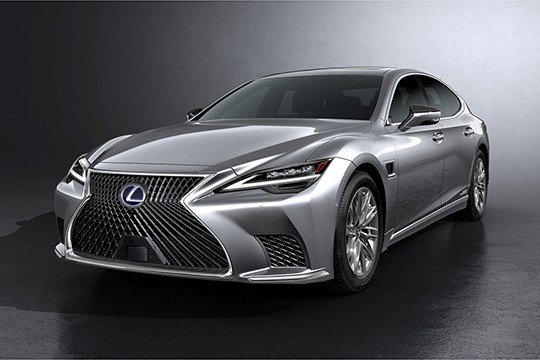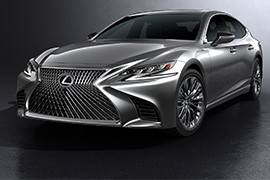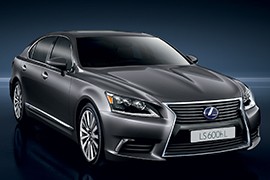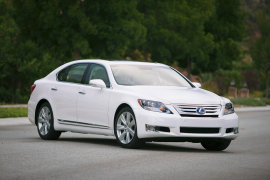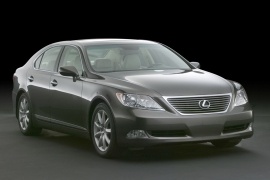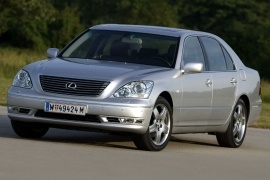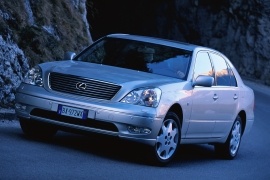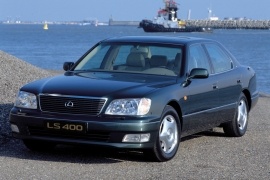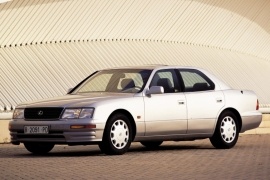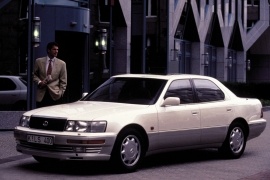LEXUS LS Models/Series Timeline, Specifications & Photos
First production year: 1990
Engines: Gasoline, Hybrid, Hybrid gasoline
Lexus introduced the fifth generation of the LS in 2017 and updated it in 2020, after three decades on the market. It was the real Japanese alternative for the luxury German brands.
By 2020, most car-customers within the premium segment knew that Lexus was founded as the Toyota's premium brand. Lexus made a name of itself by topping the reliability charts all over the world, and offering hybrid versions long before they were a cool thing. The 2020 LS was updated with new features and technologies.
From the outside, there were minor modifications to the bodywork. At the front, the car featured a redesigned air-scoops in front of the wheels, with a mesh-grille instead of horizontal slats. At the bottom, the car-maker installed the radar for the adaptive cruise control system on the main grille. The air-vent behind the front wheel-arches was new as well. In the back, the designers applied a new design for the apron.
Inside, the 2020 model featured a wrap-around sensation of the dashboard, which was continued on the door panels with the same materials and textures. The screen for the infotainment system was fitted with a 12.3" screen. It wasn't a touch-screen, but it was Apple CarPlay and Android Auto compatible. To access its menus, Lexus installed a touch-pad on the center console.
For the drivetrain, the car-maker installed the same powertrain as before: a twin-turbo 3.5-liter V6 plus an electric motor. It offered the LS500 with either a rear or an all-wheel-drive system.
Lexus introduced the fifth generation of the LS in 2017 at the North American International Auto Show, and it was a shocking appearance due to its aggressive look compared to its predecessor.
It looked like the Japanese automaker decided to take its gloves off and went on the full offensive with the LS lineup. The car was no longer a subtle premium sedan but a car that resembled some design cues from the LFA supercar. Its interior, on the other hand, remained luxurious but with a sporty touch, while the drivetrain boasted 400+ horsepower.
The LS looked sporty thanks to its sharp lines, angular headlights, and massive spindle grille on the front fascia. Lexus's target seemed to be no longer Mercedes-Benz or Cadillac but BMW and Audi. Moreover, the automaker offered it with a sport trim that added even more aggressive-looking details, such as the side scoops under the sides of the lower bumper and big, up to 20" light-alloy wheels. Yet, at the back, it didn't install any wing or spoiler on the trunk.
Inside, depending on the trim level, the automaker installed a pair of bucket seats at the front with or without high-bolstered areas. At the same time, the rear bench was the same for the entire range, with leather upholstery and a folding armrest in the middle. The cabin was wide enough to host three people abreast. Still, there was insufficient legroom for the one seated in the middle due to the tall transmission tunnel. At the front, the LS sported a big screen in the middle flanked by two additional gauges, and atop the center stack, the automaker placed a display for the infotainment system.
Under the hood, the Japanese carmaker installed a choice of three engines with rear- or all-wheel drive system and a ten-speed automatic transmission for the gasoline-only version.
Lexus introduced the second and final facelift for the fourth generation of its flagship model, the LS series.
Toyota might have run out of money since it didn't introduce a new generation for the LS, or it tried just to postpone the fifth generation for later, to get more media coverage yearly. In 2011 Lexus launched the fourth generation of the GS and unveiled a near-production concept for the IS in late 2012. But the LS had to wait until 2017 to be completely renewed.
The design team applied the new spindle-face image on the big barge as on its smaller siblings. Even though it was still controversial, it was already a brand image, and Lexus tried to make a bold statement. The carmaker made an LED light package available that included headlights, turn signals, and fog-lights. For the first time, the LS became available with an F-Sport package, with the exclusive white-color on it.
Inside, Toyota heavily improved the LS. Its design concept revealed two distinct areas: the driver's, and the rest of the car. Lexus installed a 5.8" TFT display in the instrument cluster for the on-board computer. A new, 12.3" screen found its place on top of the center console. The carmaker considered introducing heated steering wheels on all AWD models and added a quick warm-up system for the front passengers.
For the technical department, Lexus didn't consider that there were any necessary upgrades. It offered the same 4.6-liter V8 for the entire lineup, provided with a choice of two power outputs. The hybrid version kept the same 4.9-liter V8 as the non-facelifted model.
The Lexus LS lineup included the LS 460, the LS 460 L (the long-wheelbase version) and the LS 600h hybrid.
The LS was one of the quietest and smoothest luxury sedans at that time. The LS 460 was driven by a 4.6-liter V8 engine that was mated with an 8-speed automatic transmission. As a nice feature to add to the luxury offered, the steering system was adjusting with the vehicle’s speed.
The LS 600h was equipped with a hybrid powertrain and featured a 5.0-liter V8, and together with the electric motors, it was rated at a total of 438 hp. The LS 600h was certified as a SULEV (super ultra-low emission vehicle) and was only available with the long wheelbase.
New for 2009, both sedans could be equipped with an all-wheel-drive system.
The base models were incredibly well equipped, as well as an extensive list of optional features was available.
The safety equipment included 8 airbags, ABS, electronic brake assist, ESP, adaptive headlights and tire-pressure monitoring. A smart system was added to the list of safety features: a pre-collision system that was designed to move the seats to a neutral position and automatically closed the windows and the sunroof, and tightened the belts to reduce the risk of serious injuries.
The LS lineup offered a great combination of comfort, space and luxury.
Lexus introduced the fourth generation of its flagship model, the LS, at the 2006 North American International Auto Show in January as a 2007 model year.
Toyota pushed harder into the luxury segment with the LS lineup. Not only did it fit the LS with all the safety nannies it had in its basket, but it also added fuel-efficient hybrid drivetrains and an impressive range of features to convince customers that Lexus’ flagship model was more than anything they’d ever need. Furthermore, it offered the vehicle with either a short or a long wheelbase option, so those who wanted to stay behind the wheel could have one for themselves. At the same time, those who wanted to sit back and relax while being driven could get the extended version and enjoy better legroom and more comfortable seats.
At the front, the fourth generation of the LS featured a narrower chromed grille crossed by seven horizontal slats where the brand’s badge took center stage. It was flanked by clear-lens headlights, which the automaker said it designed by taking inspiration from Baccarat crystals tumblers. On the bumper, the automaker installed a pair of air intakes on the lower side, flanked by headlights. These were needed for additional engine cooling since the upper grille wasn’t tall.
From its profile, the L-finesse design language introduced by the GS model combined convex and concave shapes to create waved shapes for the vehicle. The slightly enlarged front wheel arches were followed by the sculptured door panels that featured concave shapes on their lower sides. To emphasize them, Lexus underlined them with chromed trims. At the back, the sloped rear window was followed by a tall and short deck. Finally, the rear fascia featured broad taillights extended from the quarter panels onto the trunk lid, while the lower side of the bumper revealed flat and horizontal exhausts.
Inside, the car sported leather upholstery covering the seats, door cards, and dashboard parts. To enhance the luxurious cabin, the automaker added real wood trims on the center console, the steering wheel, and the mid-line of the dash panel. The driver fronted an instrument cluster with a simple layout that sported a wide tachometer and a speedometer flanked by the fuel level and the coolant temperature gauges. Atop the center stack, Lexus added a touchscreen for the infotainment system that featured an HDD-based navigation system and 14 gigabytes of storage for audio files, and it sent its music through a 19-speaker Mark Levinson sound system. In the back, the automaker installed powered seats that could recline to provide a more relaxing journey for those seated there.
Lexus offered the car with a choice of two V8 engines: a 4.6-liter and a 5.0-liter hybrid. Both sent their power to the rear wheels via an eight-speed automatic transmission. The all-wheel independent suspension and the long list of safety systems were also part of the LS’ standard package.
Lexus put the best technologies in the third generation of the LS in 2000, and then it made it even better in 2003.
The third generation of the Lexus LS was the first vehicle to receive a five-star anti-theft rating globally, leaving the car-thieves behind with its technology. The Japanese carmaker wanted to ensure its customers that they will have the vehicle as long as they wish. Moreover, it tried to protect them as well as they could by installing advanced safety systems.
Lexus slightly redesigned the exterior for the refreshed model and introduced slimmer fog lights and a different bumper. Its headlights received a significant upgrade with the HID (Bi-Xenon), while the taillights received a full-LED system. But its overall lines were similar to the Mercedes-Benz E-Class, and that spoiled the brand's originality.
Inside, the walnut wood-trims on the dash, doors, and center console from the non-facelifted version were kept—the facelifted version carried over the DVD-based navigation system and Lexus Telematic infotainment unit. An important step forward in the safety department was the introduction of the knee airbag to complement the dual front and side curtain airbags.
Under the hood, there was no surprise to find the same 4.3-liter V8 that provided 282 hp. The engine sent its power to the rear wheels via a 6-speed automatic transmission.
Lexus didn't have the charisma and the brand awareness as its main rivals, so it struggled to create a better car than its competitors.
The third generation of Lexus' flagship model debuted at the 2000 North American International Motor show, and, at first sight, it looked like its designers peaked at German premium carmakers. But when the vehicle was thoroughly studied, it revealed that it was a better-build machine.
Toyota put all the technology it had inside the LS. The Japanese automaker went on to create smaller gaps in the bodywork and studied every single piece of the panels to make them look perfect. The design team, on the other hand, lacked the imagination to create something unique. The car's big headlights resembled the shape of a Mercedes-Benz, and the grille was crossed by thin horizontal slats. The proportions were close to those of an S-Class, while the taillights looked very similar to those from an E-Class, spread between the rear quarter panels and the trunk lid.
Inside, the combination of wood and leather was a must for every flagship model created by a premium automaker, and so was the LS. The gate for the automatic transmission shifter was similar to the one from a Mercedes-Benz. But the fit and finish were just impeccable. Moreover, the carmaker insisted on technology and installed a black and green screen atop the center stack with buttons on its rim to show and control various functions of the vehicle, including the excellent HVAC. In addition, the long wheelbase led to ample legroom for the rear passengers.
Under the hood, Toyota installed only one engine paired as standard with a five-speed automatic transmission. While it couldn't offer the vast range of engines as its competitors, it created the best in its class powerplant in terms of efficiency, power, and low vibrations.
After just three years since it launched the second generation, Lexus refreshed its flagship model, the LS.
When the Japanese carmaker started introducing the Lexus as a premium brand on the U.S. market, it brought different vehicles than the standard U.S. specifications Toyota. The LS, for instance, was the Japanese Toyota Celsior, which was not available anywhere else. For its flagship model, Toyota offered just the best technologies it had, and that's one reason why it refreshed the lineup after only three years.
For the 1997 model, Lexus improved its quality control and soundproofings. On the exterior, the carmaker redesigned the front fascia that sported a new grille. The door-mirrors were changed as well to diminish the wind noise. Last but not least, the carmaker deleted the regular power-antenna, with a rear-window incorporated one.
Inside, the car received an on-board computer that showed the fuel consumption, estimated range, and daily trip meters. A new climate control system with an improved filter found its way under the dashboard. The center stack featured an optional CD-based navigation system. It wasn't very advanced, but it could show directions better than a normal map.
Under the hood, Lexus kept the same engine as before, but it replaced the four-speed automatic gearbox with a five-speed one. Thus, it improved the car's performance and the fuel-efficiency.
Lexus introduced the second generation of the LS model in late 1994 as a 1995 model-year on the U.S. market.
While the first LS generation stood on the market for five years, the second generation lasted for six years. The Japanese premium carmaker tried and succeeded in improving the model, despite the overall appearance. It looked somehow similar, but it was different from tip to toe.
It's classic styling with a three-box sedan shape was typical for a luxury sedan from those times. The front fascia featured a broad rectangular grille and same-shape headlights with corner-mounted parking lights. Its plastic, wrapped-around bumper sported the turn signals on the upper side, on the corners, while the lower part included a center grille. At the back, the taillights were split between the rear quarter panels and the trunk lid.
Inside, Lexus added almost two inches to the wheelbase from 110.8" (2814.3 mm) to 112.2" (2849.9 mm), increasing the legroom for the rear seat passengers. Not like they didn't have enough, but on the new model, they could stretch their legs. The carmaker worked hard to improve the soundproofing and transformed the cabin into one of the most silent on the market. Despite the added length and increased sound-deadening materials, the 1995 LS was 209 lbs (95 kg) lighter than its predecessor.
Under the hood, Toyota installed an upgraded 4.0-liter V-8 engine with better fuel efficiency, more power, and more torque. It paired it as standard with a four-speed automatic transmission.
When Toyota entered the premium segment with the newly founded Lexus brand, the LS was not only its flagship but also became the best-selling product in the lineup.
When Honda introduced the Acura premium brand on the U.S. market, many people thought that the carmaker's management was not precisely connected to reality, but the facts showed otherwise. Toyota was already working on a similar project, but it wasn't ready yet. But it was made available in 1989, and the LS was the most essential piece of the puzzle.
While some could argue that Toyota's designers took their inspiration from Mercedes-Benz, the reality was that the LS was a better-built vehicle with narrower gaps between the body panels. Moreover, the car impressed with its big, rectangular headlights and the chromed trim around the grille. In addition, the bumper hosted extensive turn signals and, in the apron, there were standard foglights.
For upholstery selection, Toyota had to choose between 24 different types of leathers and opted for the best of them. There were no compromises whatsoever. The craftmanship of the front bucket seats and the comfortable rear bench matched Mercedes-Benz and BMW standards, which were considered the most important competitors. The instrument cluster hosted four clearly drawn and arranged dials with green on black illumination. At the same time, on the center stack, the carmaker placed a very complicated yet impressive sound system.
Under the hood, Toyota installed its best available engine, a 4.0-liter V8, which was very reliable and fuel-efficient for its segment. Then, to top it all off, it paired it with one of the smoothest four-speed automatic transmissions from that era.
